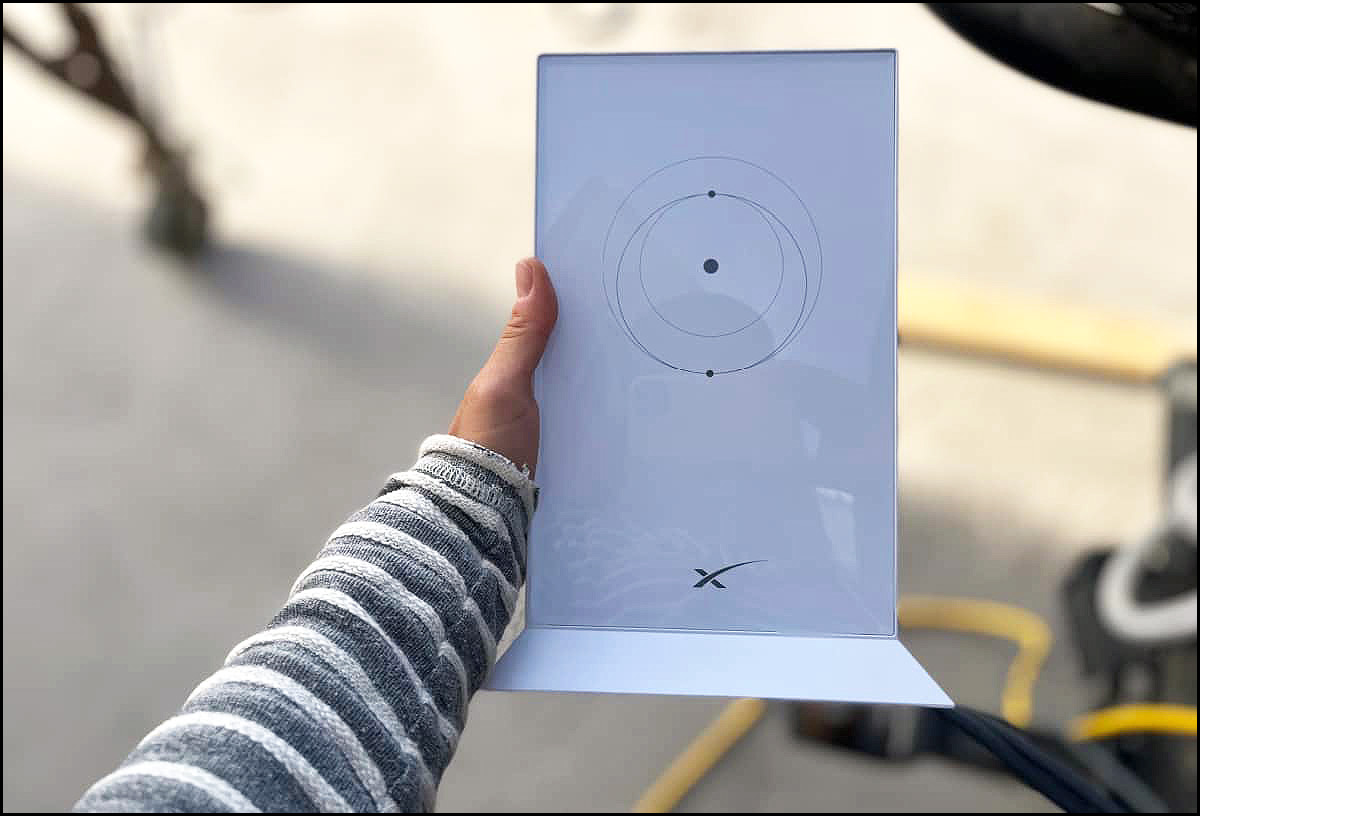This post is a shoutout to my buddy Don, who asks "How does this whole Starlink thing work anyway? What are the Ukrainians getting from us?"
No problem. Each Starlink kit comes with a small dish—referred to by fans as dishy or McDishy—which connects via the Ka-Ku band to Starlink's constellation of satellites in low-Earth orbit:
 Dishes can be mounted in lots of different ways but must have a clear view of the sky. Second-generation dishes, like the one shown above, connect via a cable to a Starlink WiFi router:
Dishes can be mounted in lots of different ways but must have a clear view of the sky. Second-generation dishes, like the one shown above, connect via a cable to a Starlink WiFi router:
 The router has two ports. One connects to the dish and the other connects to power:
The router has two ports. One connects to the dish and the other connects to power:
 After you've given the dish a few minutes to orient itself, go into your phone's WiFi settings and connect to the Starlink network. If everything has gone right, you're in business.
After you've given the dish a few minutes to orient itself, go into your phone's WiFi settings and connect to the Starlink network. If everything has gone right, you're in business.
Each kit costs about $600 unless you want the upgraded business kit, which costs $2,500. Monthly costs are $110 for standard service and $500 for the faster business service. Both include unlimited data usage.
So what is Ukraine getting? The good news is that the Ukrainian army says the small size and portability of Starlink kits is a godsend:
For war-torn Ukraine, Starlink has become an information lifeline....Ukraine’s Digital Transformation Minister Mykhailo Fedorov reported there are more than 10,000 Starlink terminals now operating in Ukraine, according to NBC. Unlike cellphone transmission towers, the satellite dishes used by Ukrainian forces for Starlink reception are small—about 23 inches wide—and readily movable to evade detection and retaliation. A Ukrainian soldier identified as Dima—his last name was withheld—told journalist David Patrikarakos: “Starlink is what changed the war in Ukraine’s favor. Russia went out of its way to blow up all our comms. Now they can’t. Starlink works under Katyusha fire, under artillery fire. It even works in Mariupol.”
The terminals are also resilient and adaptable.....When Russia resorted to electronic countermeasures, Starlink simply pushed out software updates to prevent these, according to Dave Tremper, director of electronic warfare at the Office of the U.S. Secretary of Defense. Temper said the speed at which Starlink countered the attack was “eye-watering.”
The (somewhat) bad news is that all this Starlink equipment is not a purely charitable donation from the company, as Elon Musk kinda sorta seemed to imply. The Washington Post reported about this a few weeks ago:
The United States Agency for International Development (USAID) announced it has purchased more than 1,330 terminals from SpaceX to send to Ukraine, while the company donated nearly 3,670 terminals and the Internet service itself.
....USAID agreed to purchase closer to 1,500 standard Starlink terminals for $1,500 apiece and to pay an additional $800,000 for transportation costs, documents show, adding up to over $3 million in taxpayer dollars paid to SpaceX for the equipment sent to Ukraine.
In a letter to SpaceX last month outlining the deal, the USAID mission director to Ukraine said the terminals...come with three months of “unlimited data.”
....It is [] unclear whether the price the U.S. government is paying for individual Starlink units matches their typical market price. USAID is paying $1,500 for each standard terminal and the accompanying service, documents show. According to the Starlink website, a standard terminal set costs $600, while the monthly service charge costs $110, plus an additional $100 for shipping and handling.
According to The Verge, Starlink recently unveiled a separate premium service that prices the equipment at $2,500 and the monthly Internet charge at $500, but it remains unclear whether that is what Ukraine has received.
So the US has paid $3 million so far, and the units donated by Starlink come with only three months of data. Nobody seems to know if this is for standard kits or business kits.
There's nothing really wrong with this. Just keep in mind that it's more a discounted price than a pure charitable donation.

Good post! I hope Mr Musk keeps the service for Ukraine really cheap. But maybe not?
For three million dollars we can’t complain. Especially if it’s helpful when we send Ukrainians intel and stuff. It’d be cheap at ten times the price
I wonder of a non nuclear EMP would disrupt the service?
Also like in the cold war I'm sure someone in Moscow is busy drawing up plans for building their own starlink type system
I don't know how much the howitzers we're sending them cost, but I wouldn't be astonished to learn it was 3 million dollars apiece.
I'm glad that's working so well. But, also shows its niche.
I know plenty of people who live in rather "rural" areas that have it and find it a lifesaver. So, if its niche is someplace that costs a ton to feed cable or fiber to, that's a mighty big niche.
Very true. Much better than the old satellite cable/internet from what I can tell. But that applies to only a few percent of the population overall, though perhaps a majority in rural states. The competition will be from other companies trying the same thing and may be from cell phone internet in the in-between areas.
Now, will there be a case that turns your regular phone into a satellite phone???
The dish is also a heated cat bed that can comfortably seat five.
As we used to say back when film came in at 11:
Elon Musk is a liar. Film at 11.
I don't much like Musk. He's a jerk, and he can be quite stupid when he wants to be.
But he does seem here to have done a lot of good.
Pingback: How does Starlink work? Are the Ukrainians thrilled with it? | Later On
This twitter thread has some really interesting and cool information about how StarLink is being used:
https://twitter.com/TrentTelenko?ref_src=twsrc%5Etfw%7Ctwcamp%5Etweetembed%7Ctwterm%5E1523791050313433088%7Ctwgr%5E%7Ctwcon%5Es1_&ref_url=https%3A%2F%2Fwww.dailykos.com%2Fstory%2F2022%2F5%2F10%2F2097144%2F-Ukraine-s-Incredible-Artillery-Advantage
Oops, wrong link. Try this one:
https://twitter.com/TrentTelenko/status/1523791050313433088?ref_src=twsrc%5Etfw%7Ctwcamp%5Etweetembed%7Ctwterm%5E1523791050313433088%7Ctwgr%5E%7Ctwcon%5Es1_&ref_url=https%3A%2F%2Fwww.dailykos.com%2Fstory%2F2022%2F5%2F10%2F2097144%2F-Ukraine-s-Incredible-Artillery-Advantage
So since it is satellite, one is already "emitting" but I'd think an option for some hard-wired ports on the router might be worthwhile.
@Rick Jones
I'm sure extra ports will be available for an additional charge on a future "next generation," after a sufficient number of the devices have been sold to early adopters.
Another new technology put to use in the field of battle, even if it's used defensively. Meanwhile, Musk continues to pollute the skies with hundreds (thousands?) of shiny little satellites that are visible to the naked eye, unchecked by any government. Today's kids will never know first-hand what a "starry sky" looks like. (And today's Milky Way photographers will have many more obstacles between their lenses and the cosmos.)
I meant to write "...starry night..."
1,330 terminals purchased @$1,500 each is $1,995,000.
3,670 terminals donated.
So 5,000 terminals total.
@$600 each would have been $3,000,000. So on net, it's a "buy 2, get one free" sale.
StarLink is donating three months service, which would retail for a bit.
3 months service @ $110 per terminal x 5,000 terminals = $1,650,000
So StarLink is giving up $2,650,000 in potential revenue ($1,000,000 on the donated terminals and $1,650,000 on three month's service).
If StarLink is having trouble selling terminals and subscriptions at full price, then the potential revenue was never going to materialise.
To add to the "how Starlink works" part of the post, the antenna on your house is connected to the Starlink satellite in the space, which then relays the traffic to a local (<500 miles away) ground station. So the satellite is basically acting as a wireless relay between the user's home station and the ground station, which is the gateway to the internet.
In the future, Starlink plans for the satellites to relay traffic directly between them via lasers, so the traffic can be passed around the globe directly within the satellite network (it will eventually have to come back down to a ground station connected to the internet somewhere on the globe). This satellite-to-satellite laser communication is also what makes Starlink so valuable to the financial markets because it will enable transoceanic links that can beat the fiber optic links as far as latency goes.
Will Starlink work as well as Tesla Autopilot?
The problem with traditional satellite systems is that the dish has to be aimed at the geosynchronous satellite that handles the data. The better your aim, the better the data link. That can be a problem if you have to move often. Older multi-satellite systems, like Iridium, have extremely limited capacity. You can do SMS and voice, potential life savers, but you can't do much with modern web content. Starlink's dense mesh web provides a good data link without precision aim. The satellites are moving, so there is no fixed target to aim at. The satellites use mesh routing to distribute the load much like a home mesh router. Data doesn't have to go through a dedicated central station.
The system is pretty robust because internet package switching was designed to get around failure points. This was one reason its development was supported by the military. The basic idea of dynamic data routing is older. One of the early developers, in the 1930s, was Hedy Lamarr, later a Hollywood movie star, who wanted to solve the problem of guiding torpedoes and other munitions by radio even when channels were being jammed. She came up with what we now call TDMA, an impressive feat in the days of vacuum tubes and relays.
Starlink is a great but limited solution. It can provide wide area coverage at high bandwidth, but the overall bandwidth of the system is limited by the capacity of the mesh network. It's well suited for warfare because it is hard to knock out from the ground and provides plenty of coverage for the battlefield. It's not as well suited for the problem of providing rural broadband.
Musk is great at hyping technologies and has good connections, especially with other South African immigrants, in the VC community. His reach often exceeds his grasp. He is still insisting that Tesla provides self-driving cars though that is likely decades away. He is miles from being able to sell home battery storage units, though others are delivering just fine. (We recently installed a system from a competitor.) Shotwell at SpaceX seems to have finally gotten him to stop scaring customers with tweets of kaboom. Starlink is not a solution to the rural internet problem. Obviously, he preps a good deck, so he can get the money flowing. That's definitely good enough.